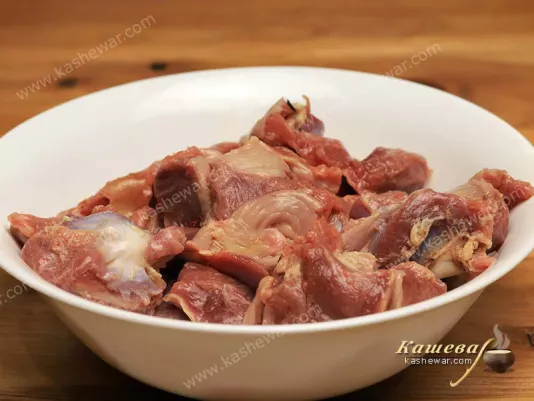Fettuccine with Giblets
Fettuccine with Giblets – a wonderful recipe for lunch or even dinner, it is prepared very easily and quickly.

Chicken Giblets are a true treasure in the kitchen, often underestimated. Over the years of cooking, I’ve realized that they can give dishes a unique character and depth of flavor. In my practice, liver, hearts, and gizzards have often become the base for hearty soups, delicate pâtés, or refined main courses. I especially value them for their nutrition: they’re rich in protein, iron, and essential trace elements. Through the years, I’ve developed techniques to make these ingredients tender and aromatic, because proper preparation is the key to success. In my family, there’s always a place for giblet dishes, and I can confidently say: they deserve your attention. My experience shows that even familiar recipes can take on a new life when chicken giblets are used.
Over the years of cooking, I’ve realized that preparing chicken giblets is half the success of the dish. First of all, I always wash the hearts, liver, or gizzards thoroughly under running water, removing excess fat and membranes. My experience shows that these little details affect the texture and flavor of the finished dish. It’s important not to over-dry the liver during handling: I leave it slightly moist to keep its tenderness. I always boil gizzards before braising – this makes them soft and easy to pair with other ingredients. I also use soaking in milk: I especially value this trick because it helps remove bitterness from the liver. Over the years, I’ve learned that proper preparation preserves the nutrition of the product and makes it the foundation for dozens of recipes. Skip this step, and not even the best sauce can save the dish from failure.
In my hands, chicken liver always turns into a tender, aromatic dish. I’ve found that the main secret lies in temperature: too much heat dries it out, while slow braising preserves juiciness. The best results come when I sear the liver quickly, just a few minutes on each side, and then let it “rest” under a lid. Over time, I’ve developed a pâté recipe that never fails: liver sautéed with onions, carrots, and a little butter becomes the base for a smooth, creamy spread. I especially love this option because it works both for festive tables and everyday snacks. My experience shows that adding a pinch of aromatic spices – nutmeg or cinnamon – reveals new layers of flavor. Sometimes the dish fails if the liver is overcooked, so I always monitor the process carefully to achieve exactly the tenderness my family expects.
Over the years, I’ve learned to cook chicken hearts so they remain tender and flavorful. In my family, they’re especially loved in soups and salads, but I’ve also developed several braised recipes. The secret lies in pre-boiling: I always boil the hearts for 15–20 minutes before adding them to a dish. My experience shows this makes them soft and removes excess blood that can spoil the taste. I like to season them with a mix of black pepper, bay leaf, and a touch of dried garlic – it gives the dish harmony. I especially appreciate hearts for their versatility: they’re equally good in salads and hot meals. Over the years, I’ve learned the main rule – don’t overcook, or they become tough. Sometimes the dish may turn out too dry, so I add a little broth or sour cream to keep them juicy.
My experience shows that chicken gizzards need special treatment, as they’re dense and require long cooking. Over the years, I’ve found the best results come from pre-boiling for about an hour, followed by braising with vegetables or baking. I often combine onions, carrots, and tomato sauce to make gizzards tender and flavorful. I especially like serving them with mashed potatoes or rice – always a hearty and balanced meal. I’ve found the perfect spice balance: coriander, pepper, and bay leaf create a fragrant base. Over the years, I’ve learned to control cooking time: cut it short and the dish will be tough, overdo it and you lose texture. That’s why I always recommend keeping an eye on consistency. In my family, these dishes are especially valued during the colder months, when we crave warmth and heartiness.
In my practice, I’ve seen how chicken giblets are used in cuisines around the world. Over the years of cooking, I’ve realized they always find their place: in French cuisine, liver is turned into delicate pâtés; in Asian cooking, hearts and gizzards are added to noodle soups; in Mediterranean countries, they’re braised with plenty of vegetables and spices. I especially value this ingredient for its versatility: no matter the country, there’s always a way to include it in traditional dishes. My experience shows that chicken giblets don’t need expensive ingredients to shine – just the right technique. In my family, we often try adapting dishes from different cultures to our own tastes, and giblets provide the perfect base for that. Over the years, I’ve learned to trust my instincts: if the ingredient is fresh and properly prepared, it will always deliver excellent results.